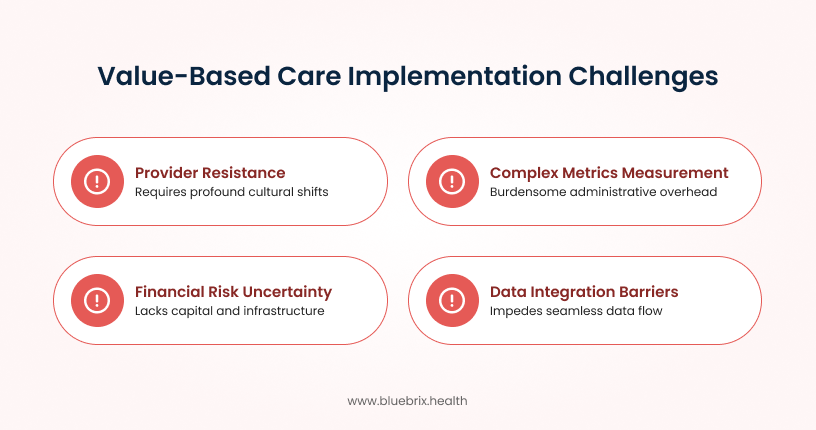
For too long, the healthcare industry has been stuck in a transactional, fee-for-service system that rewards volume, not value. The shift to value-based care was meant to change this, but it faces significant friction: administrative burden, financial uncertainty, and a lack of scalable infrastructure.
What if we could solve these challenges by borrowing a page from the playbook of companies like Uber, Airbnb, and Amazon?
My team at blueBriX and I have analyzed over 75 sources—from government reports to academic studies—and the research is clear: Value-based care is already evolving toward a platform-based, “Uber-like” model. This is not a distant theory; it’s happening right now.
What’s Holding Back Value-Based Care?

- Provider Resistance: We’re talking about a profound cultural shift here. Moving away from the ingrained fee-for-service mindset requires a massive cultural shift away from the ingrained fee-for-service mindset. It’s a huge ask.
- Financial Risk Uncertainty: Many providers, especially smaller practices, just don’t have the capital or infrastructure to handle the financial risk that comes with value-based care contracts.
- Complex Metrics: Defining and accurately measuring “value” and “quality” isn’t straightforward. This often leads to a burdensome amount of administrative overhead that gets in the way of providing care.
- Data Integration Barriers: This is a foundational problem. Without a seamless flow of data across different systems, providers can’t get a complete, holistic view of their patients. This single barrier impedes value-based care success more than almost anything else.
These challenges are why value-based care hasn’t yet reached the scale many of us had hoped for. But while we’ve been working to overcome these internal barriers, I’ve seen a new and unstoppable force gaining momentum from the outside. The rise of the platform economy.
The Platform Economy: A Solution to Value-Based Care’s Biggest Problems
The rise of the platform economy directly addresses these long-standing problems. The very principles that make the Uber model so successful—network effects, algorithmic matching, and on-demand service—are exactly what’s needed to overcome the core limitations of value-based care.
Think about it this way:
- Solving the Scale Problem: Value-based care struggles to reach scale because it’s hard to build and manage the complex networks of providers, payers, and patients. A platform solves this by creating a single, integrated digital ecosystem.
- Breaking Down Data Silos: Value-based care can’t work without a complete, holistic view of the patient. A platform acts as a central hub, enabling the seamless flow of data across different systems.
- Expanding Access: Value-based care is about getting patients the right care at the right time. A platform allows for on-demand services, whether it’s a virtual visit or a ride to a specialist, breaking down traditional scheduling and geographic barriers.
We’re already seeing this happen. Telehealth platforms were the early pioneers. Now, we have specialized platforms for gig-economy nursing (CareRev) and non-emergency medical transportation (Uber Health). Big tech companies like Amazon, Google, and Apple are all building their own health platforms, using their vast technical expertise to connect patients to care and manage their health data.
The promise is powerful. The Uber analogy works because it addresses what’s often missing in healthcare today: convenience, coordination, and responsiveness. These models connect people to what they need, when they need it, and offer clear parallels to the Uber model.
The Peril: A Balanced View of the Risks
But as with any major transformation, this new path isn’t without its potholes. From my perspective, we have to be honest with ourselves and acknowledge the significant risks that come with adapting an Uber-like model to healthcare. I’ve seen firsthand how a focus on speed and efficiency can, if we’re not careful, inadvertently compromise the very values that define our industry.
The research also backs this up, suggesting that the effectiveness of these models is still a mixed bag. And there are some serious concerns we need to address head-on:
- Financial and Workforce Strain: This is something that keeps me up at night. The platform operators often take a significant slice of the pie—sometimes as much as 15-30%—which can seriously reduce provider margins and put a huge strain on smaller practices. On top of that, the “gig-style” employment model creates unstable work for our most valuable asset: our clinicians. This can lead to inconsistent pay, high stress, and greater burnout, which is the last thing we need when we’re already facing a major retention crisis.
- Algorithmic Oversight: What happens when the algorithm that matches a patient with a provider prioritizes speed or cost over the patient’s specific needs? As an industry, we rely on clinical judgment, not code. The opaqueness of these systems makes it incredibly difficult for regulators to ensure fairness and effectiveness. We have to be vigilant that the platform’s priorities never trump a provider’s clinical judgment.
- Quality and Safety: Healthcare isn’t a transactional business; it’s a relationship business. The trust and familiarity that come from long-term patient-provider relationships are crucial, especially for managing chronic conditions. With rotating staff, we risk fragmented care and communication gaps that could affect patient safety and outcomes.
- Ethical Considerations: From where I stand, this is a fundamental issue. An overly transactional approach could reduce care to a series of “tasks” rather than an ongoing relationship. This can limit a provider’s autonomy if algorithms dictate their workflow or priorities and, in the worst cases, place financial optimization ahead of patient-centered values. We must not allow the convenience of the platform to erase the compassion of care.
- Regulatory Gaps: Our current regulatory framework was built for a different era, not for a digital, platform-based future. This creates confusion around everything from state-by-state licensing barriers to new gaps in HIPAA rules. If we want this model to succeed safely, we need new governance frameworks and stronger consumer protections that ensure transparency and hold platforms accountable for the quality of care they facilitate.
The evolution of value-based care toward platform-based models is inevitable, but its ultimate success—whether it’s a force for progress or peril—will depend on how all of us, as stakeholders, navigate this transformation. The stakes are nothing less than the future of healthcare delivery itself.
The Path Forward: Our Recommendations
I believe we all have a crucial role to play. Here’s how I think we should approach it, whether you’re a provider on the front lines or a technology leader shaping the future:
- For Healthcare Providers: Don’t be a passive observer. This shift is happening, and you need to be ready. Assess your practice’s readiness for platform-enabled care and make strategic investments in the data infrastructure and analytics capabilities you’ll need to succeed. Most importantly, while you embrace these new tools, never lose sight of the patient relationship—it’s the core of what we do.
- For Payers and Health Plans: My message to you is this: as you build partnerships with these new platforms, you must maintain stringent quality oversight and accountability. Develop sophisticated risk management approaches that are tailored to these models and invest in robust data capabilities for comprehensive population health management. Your role is to guide this ecosystem, not just to fund it.
- For Policymakers: Our regulations are built for a different era, and they’re holding us back. We need to modernize our frameworks to enable innovation while protecting patients. This means addressing state-by-state licensing barriers and closing the gaps in HIPAA rules created by large-scale platforms. We need new governance frameworks and stronger consumer protections that ensure transparency and hold platforms accountable.
- For Technology Companies: This is a call to action. Don’t just rush to market. Develop deep healthcare expertise before you scale your solutions. Prioritize ethical AI implementation and invest in privacy and security infrastructure that goes beyond basic compliance. Engage meaningfully with healthcare stakeholders throughout your development process—we’re your partners, not just your customers.
The question is no longer “if” value-based care will adopt platform models—it’s how we steer that evolution. Done right, this shift can unlock unprecedented efficiency and equity; done poorly, it risks eroding trust, quality, and sustainability. The stakes are nothing less than the future of healthcare delivery itself.